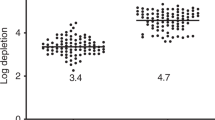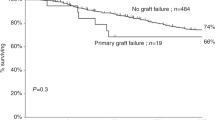Abstract
Eleven patients with high-risk hematologic malignancy received cryopreserved but otherwise unmanipulated blood cell transplants (BCT) from partially mismatched family members in whom progenitor cells had been mobilized by G-CSF. Donors were mismatched by up to one antigen in the GVH direction and up to three antigens in the rejection direction. Outcomes were compared with those of 22 patients receiving BCT from fully matched donors. Two mismatched patients died without engraftment on day 21 and 32. One had rejected bone marrow from the same donor, the other was mismatched by two antigens in the rejection direction and received the lowest dose of CD34+ cells. Median time to granulocyte engraftment was 21.5 (range 16–33) days for the mismatched group compared with 16 (11–28) days for the matched group (P = 0.01). No correlation was found between CD34+ cell dose and time to granulocyte or platelet recovery. In the mismatched and matched BCT groups respectively, the risk of grade II–IV acute graft-versus-host disease (GVHD) was 73% vs 28% (P = 0.001) and of chronic GVHD 100% vs 78% at 18 months (P = 0.01). The relationship of T cell dose to acute GVHD could only be evaluated in the matched group and no correlation was found. One of 11 mismatched patients and eight of 22 matched patients had relapse or persistent disease. Disease-free survival at 1 year was similar at 55% for mismatched and 50% for matched BCT. These results indicate that allogeneic BCT from partially mismatched family members is accompanied by a high incidence of GVHD but may result in comparable survival to BCT from fully matched donors.
This is a preview of subscription content, access via your institution
Access options
Subscribe to this journal
Receive 12 print issues and online access
$259.00 per year
only $21.58 per issue
Buy this article
- Purchase on Springer Link
- Instant access to full article PDF
Prices may be subject to local taxes which are calculated during checkout
Similar content being viewed by others
Author information
Authors and Affiliations
Rights and permissions
About this article
Cite this article
Russell, J., Desai, S., Herbut, B. et al. Partially mismatched blood cell transplants for high-risk hematologic malignancy. Bone Marrow Transplant 19, 861–866 (1997). https://doi.org/10.1038/sj.bmt.1700757
Received:
Accepted:
Issue Date:
DOI: https://doi.org/10.1038/sj.bmt.1700757
Keywords
This article is cited by
-
Individualized exercise program for the treatment of severe fatigue in patients after allogeneic hematopoietic stem-cell transplant: a pilot study
Bone Marrow Transplantation (2006)
-
Allogeneic haemopoietic cell transplants in Australia, 1996 – A multi-centre retrospective comparison of the use of peripheral blood stem cells with bone marrow
Bone Marrow Transplantation (2001)



